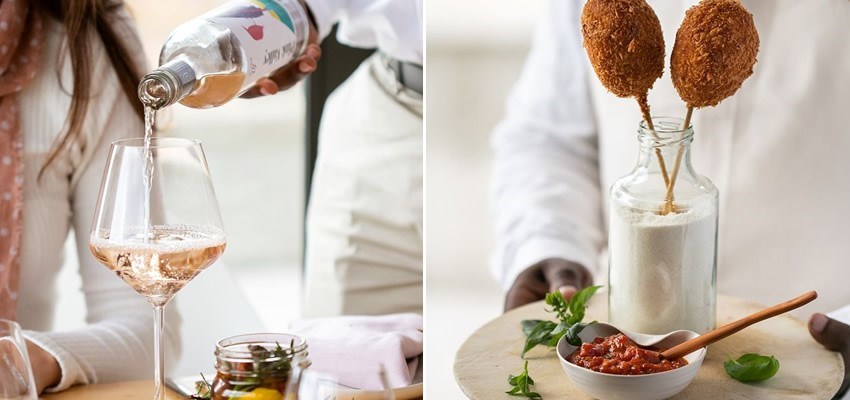This was Romond, where enigmatic and much-loved André Liebenberg offered a rustic, welcoming and unhurried wine experience (and a favourite, the ‘Rebus’ red wine). Following its sale last December, the new purchasers saw an opportunity of focussing on a style that was familiar to them at home in southern France, and a single winery for a single wine was born, which now joyously goes by the name of Pink Valley Wines.
Winemaker, CEO (and evidently farm manager, organiser and general visionary) Schalk Joubert isn’t new to the game, either, having been at Rupert & Rothschild where he sourced grapes from the valley for years. He is also a friend of André’s and you realise he has no intention of losing the best of what André created – including some very old Cabernet Franc vines and his adjacent medium scale winery.
But frantic building and re-shaping work isn’t restricted to Pink Valley, just across the slopes is Cordoba, whose purchase by the same investors was the beginning of the vision. Avoiding a licensing issue with the city in Spain, Cordoba became Taaibosch Wines, named for the abundant shrubbery whose perfume ascends the valley.
Like at Pink Valley, Schalk – in charge at Taaibosch as well - aims to preserve the best at what was Cordoba, including the once heralded ‘Çrescendo’ Red, a Bordeaux style blend, though he thinks they will specialise in Cabernet Franc and Merlot, blended usually, in future.
This is very much in-line with the team’s philosophy. Schalk aims to make wines for everyday drinkers. He quotes Robert Joseph on his visit to SA when he paraphrases that ‘the wine industry is always talking about educating its wine drinkers, but for most fast moving consumer goods – which wine is - they don’t need education, we need to demystify wine, to make it easy’.
“Consumers buy brands, not wines, price point is not so important, because it is not just the wine they are buying, it’s the occasion, the enjoyment, the sharing. They are buying the perception, the people behind the wine and the packaging”, says Schalk. True, all around we are hearing that ‘the story’ behind the wine is important.
“The focus on fewer wines, one or two, allows you to not only produce quality, but to achieve the volumes necessary to become a sustainable brand” that it takes to become a major brand in the market.
So now the vision includes two farms, the 24 hectares under vine at Taaibosch and the 9 hectares at Pink Valley.
Pink Valley will only offer a Rosé and accompany it with pork crackling and a dried apple shard, or for the hungrier maybe stuffed calamari, peach and halloumi salad, whole baked mackerel and green salad or a Boerie Papsickle. Taaibosch will be more tasting oriented, with its one red (with something like a reserve version following) on offer.

Grapes for the Rosé; Grenache, Cinsault, Syrah and a bit of Sangiovese, will be sourced from select vineyards from the Cape as certain varieties don’t suit vineyards which climb to 400 metres above sea level with a direct line of sight to Cape Point. The source for the Taaibosch reds largely sits around both properties.
Other similarities are evident, and reflect the overall concept. Sales and Marketing Manager Mark Lester (another experienced team member with years at Tokara, Lanzerac, Lourensford and Cavalli) says they are “in a fortunate and privileged position to have proprietors who; are passionate about wine, who believe in South Africa, who recognise the potential we as an industry have to offer, who are willing to invest in a vision and lastly, who understand that a solid foundation needs to be laid from the outset from which to build”. The investors have a long term vision (Schalk says “for South Africans that means ten years, for our owners it means twenty plus”). That means they don’t have to rush anything. I ask when their first red wine, a 2018 vintage, will be released, “I don’t know, it depends, maybe a year, or two”, says Schalk. It gives them time to get things right, their tasting room is open, visitors were eating, but as to an official public event, again, ‘maybe’ ‘we’ll make sure everything is perfect first, we’re going for organic growth’.
Such attention to detail follows both brands, from packaging, where the Pink Valley label carries artwork by renowned South African artist Walter Battis (“many don’t take ‘dry goods’ seriously” says Schalk, “our label has colour and vibrancy and a point of differentiation”- the label and bottle are important”).
And winemaking, his Rosé juice is cooled to 2֯ C to settle for five weeks with no sulphur, spends 5 months on its lees then is lightly filtered with no fining; it shows freshness, expression, very little colour, clean red berry fruit and 1 gram/l of sugar. His Taaibosch reds are undergoing a mixed range of 60% new barriques, some in cement tanks, some in Foudres.
Similarly, the winery environment shares the same vision. Huge work is being done on their 60-odd hectares of land, half of which is kept wild. All over, indigenous shrubs and wild olives are being planted in their thousand, landscaping is continuous, slopes abound in cascading flora, the outlook is bucolic and delightfully natural.
With such a long term vision and an unhurried approach, they don’t have to work with what they inherited but can build on the best of it, “you only have one chance to launch a winery or a wine”, says Schalk, the first wine released “can determine the next twenty years, and the incorrect approach now, can prove to be very expensive in the long-term”.
www.pinkvalleywines.com
F: @PinkValleyWines